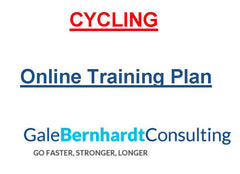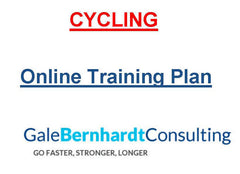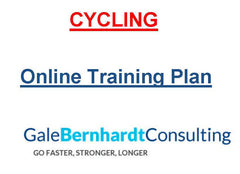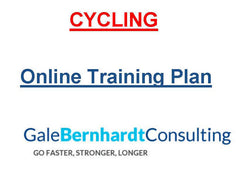Description
Mountain Biking: 100 Mile Mountain Bike Race, Level I Cyclist, 5-13.5 hrs/wk
Author: Gale Bernhardt
16 weeks - $74.95 (There is a 10% discount when ordering from Gale Bernhardt’s website.)
Total Hours: 126
Mountain bike racing at the 100-mile distance is not an easy task, no matter how you look at it. Depending on the course, only the best riders can expect to be under the 10-hour mark. For other courses, it takes a very strong rider to be under the 12-hour mark.
You are aiming for the 100-mile distance and you need to accomplish the mission with a minimal amount of weekly training time. Because your training time is limited, you need structure. You need a plan of attack.
PROFILE
Before beginning this plan, you are riding consistently and doing between five and six hours of training each week. Your long ride is around two hours long and it includes some intensity as well as hill riding. At least one other ride during the week contains some intensity. That ride can be an indoor spinning class.
If your current fitness does not meet the description above, begin your training journey by following the Level I Cyclist Base (Winter, Off-Season) Training Plan 3 to 6 hours per week, prior to this plan. After the last week of the preparation base plan, begin with Week 1 of this plan.
During the week, you are limited to an hour of training on three days. You need two days off for other activities. Additionally, you do not have time to commute to a mountain course, so the training needs to be on an indoor trainer, spin class or a road bike.
GOAL
Your goal is to comfortably complete a 100-mile mountain bike race. While you want to ride in a time that is as fast as possible, you realize you are restricted for training time. You want the best time, given your limited training time.
THE PLAN OVERVIEW
The plan begins with two, four-week cycles. This means three weeks of building volume, then a week of rest. As training volume increases, you move to two, three-week cycles to help improve recovery. The final three weeks include decreased volume so you can be fully prepared for race day.
Monday workouts are either easy rides, skills rides or form workouts. If you are currently doing a strength training program and want to keep strength training as part of your training, continue that program on Mondays. You may find you need to reduce the weights, sets, repetitions or some combination of all to keep strength training from negatively affecting your cycling.
If you are not currently strength training, but want to add a routine, see the Supporting Documents for a description of the SM phase of training and use that phase throughout the plan. Begin with very light weights and work your way into slightly heavier weights as the program progresses. There is no need to lift weights that are very heavy during this plan.
Tuesday and Thursday are days off. You may have to adjust the days off to better suit your personal needs.
Wednesday workouts are typically interval sessions. You need to be rested for these workouts to get the most out of them.
Friday workouts change some throughout the program, but stay below the one-hour limit that you need.
Saturday workouts are for mountain bike skills and building endurance. Combined with a long ride on Sunday, this two-day combination packs a punch to build your overall race endurance.
The Friday, Saturday, Sunday and Monday workout combination gives you four solid days of riding.
On the long weekend rides, be certain you are working on your nutritional strategy for race day. Iron out any equipment choices prior to Week 12 so you have time to do final testing before race day.
Enjoy the training journey and the race ~
Q – What do I get with a training plan?
A – After purchase, you will receive an email with instructions on how to download and access your training plan. Your plan will be available in your own private online training log account. You will enjoy the following benefits and more:
- Daily e-mails with your next workout keep you on track
- Create your own routes or search the library of routes for tracking your workouts
- Map, graph and share workouts with your friends by e-mail, Facebook and view in Google Maps or Google Earth
- Upload workouts from one of more than 80 training devices (Garmin, Suunto, Timex, Polar, more) or easily record your workouts manually
- Track your fitness and gain confidence
- Complete nutrition tracking to monitor your diet
- Get support and answers on a message board specific to your plan and access to more message boards.

Q – What if I don’t like the plan once I’ve seen it?
A – Because discounted plans are offered through this site and a coding system, no refunds are allowed. If you are worried about wanting or needing a refund, you can forgo the discount and purchase the plan directly from the TrainingPeaks website. Refunds for training plans are offered for a limited time after purchase. You can find this training plan on that site by following this link.
Sample workouts:
Workout #1 : Bike
Recovery - fun
Planned Time: 1:00:00
Ride at RPE Zone 1 or below. This should be very easy, a 'noodle ride.'
Workout #2 : Custom
Tip
While it is important to train, rest is also important. Hopefully you have taken a day off or a very easy training day recently - prior to beginning this training plan.
Workout #3 : Bike
Cruise Intervals - Z3
Planned Time: 1:00:00
These intervals begin work on lactate threshold speed. On a mostly flat course or indoor trainer, complete the prescribed intervals allowing heart rate to rise into the Zone 3 over the course of the interval and no higher. After heart rate is in Zone 3, try to hold it there until the end of the interval. Begin timing the interval as soon as you begin an increased effort - do not wait to begin the clock when heart rate just reaches Zone 3. All work intervals begin when effort is increased and end when effort is decreased. Rest for the indicated time between intervals.
Workout #4 : Day Off
Rest and recovery day - no training scheduled
Workout #5 : Bike
Endurance - 90rpm
Planned Time: 1:00:00
Ride in Zones 1-2 on a flat to gently rolling course at 90+ rpm. If you're unable to spin 90+ rpm coast and recover until you can.
Workout #6 : Bike
Hills, low cadence.
Planned Time: 1:00:00
Ride a hilly course, (road or mountain bike) using a gear or two bigger than you would normally use on the uphill sections. This will require you to use more force on the pedals and a lower cadence. Aim for a cadence of about 60 rpm. Increase your cadence, with 90+ rpm on the downhill sections. Most of the ride is in Zones 1 to 2. This workout can be used in place of strength training.
Workout #7 : Bike
Recovery - fun
Planned Time: 1:00:00
Ride at RPE Zone 1 or below. This should be very easy, a 'noodle ride.'
Workout #8 : Custom
Tip
Good athletic performance comes from staying healthy and training consistently.
Workout #9 : Bike
Cruise Intervals - Z3
Planned Time: 1:00:00
These intervals begin work on lactate threshold speed. On a mostly flat course or indoor trainer, complete the prescribed intervals allowing heart rate to rise into the Zone 3 over the course of the interval and no higher. After heart rate is in Zone 3, try to hold it there until the end of the interval. Begin timing the interval as soon as you begin an increased effort - do not wait to begin the clock when heart rate just reaches Zone 3. All work intervals begin when effort is increased and end when effort is decreased. Rest for the indicated time between intervals.
Hard copy of this training plan is available in the book Training Plans for Cyclists.




